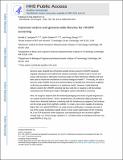| dc.contributor.author | Sanjana, Neville E | |
| dc.contributor.author | Shalem, Ophir | |
| dc.contributor.author | Zhang, Feng | |
| dc.date.accessioned | 2017-07-26T15:17:59Z | |
| dc.date.available | 2017-07-26T15:17:59Z | |
| dc.date.issued | 2014-07 | |
| dc.identifier.issn | 1548-7091 | |
| dc.identifier.issn | 1548-7105 | |
| dc.identifier.uri | http://hdl.handle.net/1721.1/110852 | |
| dc.description.abstract | To the Editor:
Genome-wide, targeted loss-of-function pooled screens using the clustered, regularly interspaced, short palindromic repeats (CRISPR)-associated nuclease Cas9 in human and mouse cells provide an alternative screening system to RNA interference (RNAi)1, 2, 3, 4. Previously, we used a genome-scale CRISPR knockout (GeCKO) library to identify loss-of-function mutations conferring vemurafenib resistance in a melanoma model1. However, initial lentiviral delivery systems for CRISPR screening had low viral titer or required a cell line already expressing Cas9, thereby limiting the range of biological systems amenable to screening.
We sought to improve both the lentiviral packaging and choice of guide sequences in our original GeCKO library1, where a pooled library of synthesized oligonucleotides was cloned into a lentiviral backbone containing both the Streptococcus pyogenes Cas9 nuclease and the single guide RNA (sgRNA) scaffold. To create a new vector capable of producing higher-titer virus (lentiCRISPRv2), we made several modifications, including removal of one of the nuclear localization signals, human-codon optimization of the remaining nuclear localization signal and P2A bicistronic linker sequences, and repositioning of the U6-driven sgRNA cassette (Fig. 1a). These changes resulted in an approximately tenfold increase in functional viral titer over that of lentiCRISPRv1 (ref. 1; Fig. 1b). | en_US |
| dc.description.sponsorship | Broad Institute. Klarman Cell Observatory (postdoctoral fellowship) | en_US |
| dc.description.sponsorship | Massachusetts Institute of Technology. Simons Center for the Social Brain (postdoctoral fellowship) | en_US |
| dc.description.sponsorship | National Institutes of Health (U.S.) (NIMH, Director’s Pioneer Award (5DP1-MH100706) | en_US |
| dc.description.sponsorship | National Institutes of Health (U.S.) (Transformative R01 grant (5R01-DK097768)) | en_US |
| dc.language.iso | en_US | |
| dc.publisher | Springer Nature | en_US |
| dc.relation.isversionof | http://dx.doi.org/10.1038/nmeth.3047 | en_US |
| dc.rights | Creative Commons Attribution-Noncommercial-Share Alike | en_US |
| dc.rights.uri | http://creativecommons.org/licenses/by-nc-sa/4.0/ | en_US |
| dc.source | PMC | en_US |
| dc.title | Improved vectors and genome-wide libraries for CRISPR screening | en_US |
| dc.type | Article | en_US |
| dc.identifier.citation | Sanjana, Neville E, Ophir Shalem, and Feng Zhang. “Improved Vectors and Genome-Wide Libraries for CRISPR Screening.” Nature Methods 11, no. 8 (July 30, 2014): 783-784. | en_US |
| dc.contributor.department | Massachusetts Institute of Technology. Department of Biological Engineering | en_US |
| dc.contributor.department | Massachusetts Institute of Technology. Department of Brain and Cognitive Sciences | en_US |
| dc.contributor.department | McGovern Institute for Brain Research at MIT | en_US |
| dc.contributor.mitauthor | Sanjana, Neville E | |
| dc.contributor.mitauthor | Shalem, Ophir | |
| dc.contributor.mitauthor | Zhang, Feng | |
| dc.relation.journal | Nature Methods | en_US |
| dc.eprint.version | Author's final manuscript | en_US |
| dc.type.uri | http://purl.org/eprint/type/JournalArticle | en_US |
| eprint.status | http://purl.org/eprint/status/PeerReviewed | en_US |
| dspace.orderedauthors | Sanjana, Neville E; Shalem, Ophir; Zhang, Feng | en_US |
| dspace.embargo.terms | N | en_US |
| dc.identifier.orcid | https://orcid.org/0000-0003-2782-2509 | |
| mit.license | OPEN_ACCESS_POLICY | en_US |
| mit.metadata.status | Complete | |
